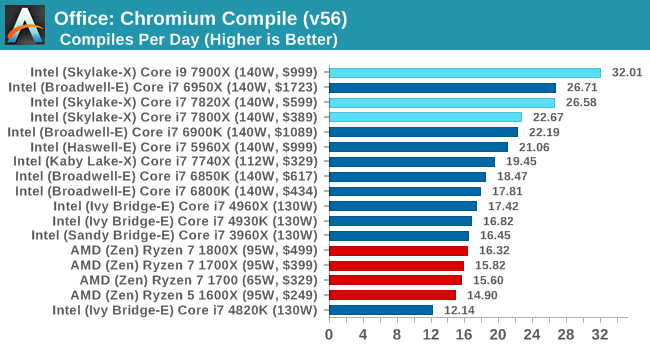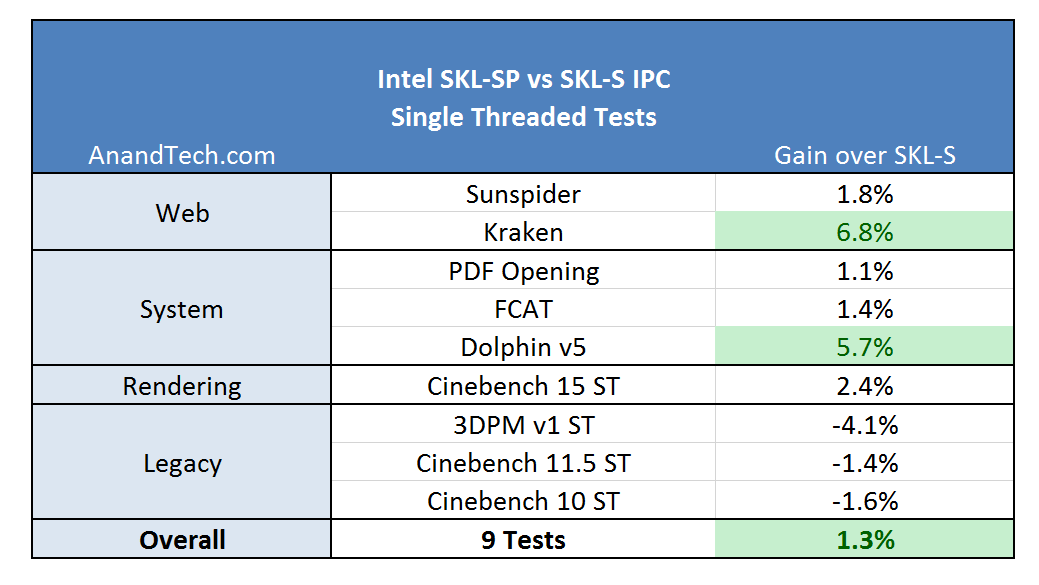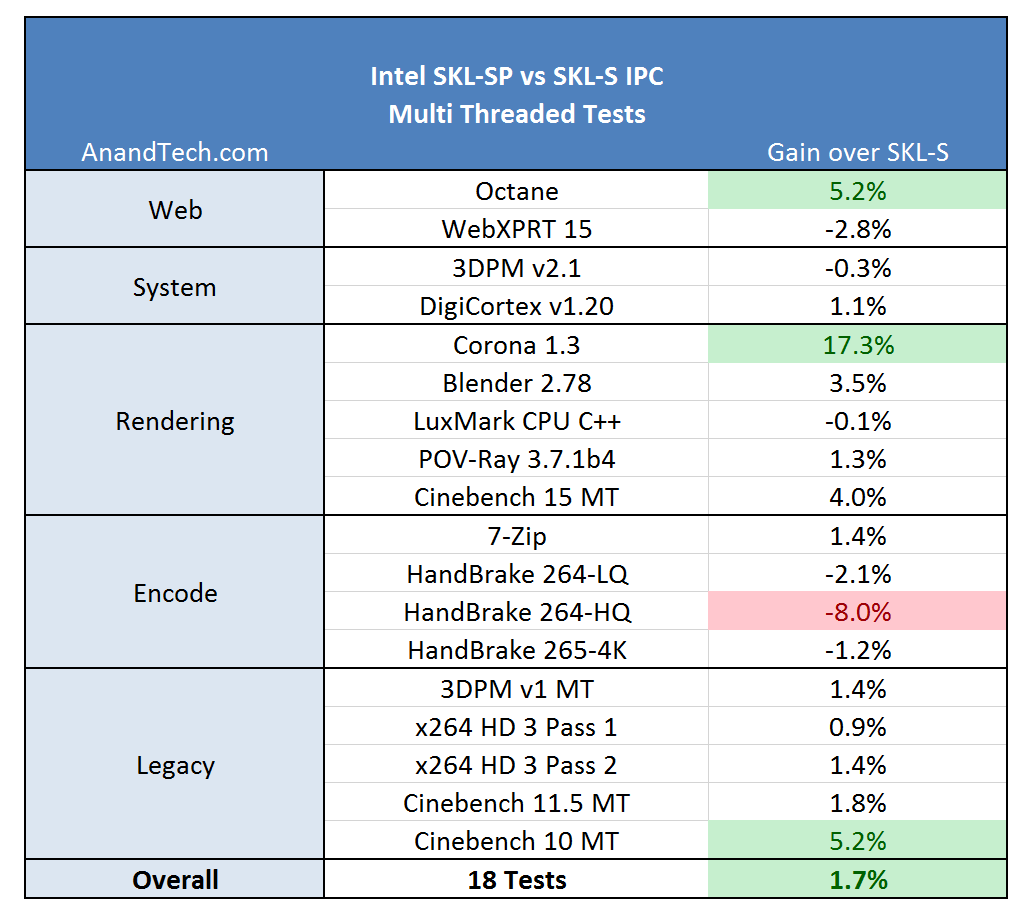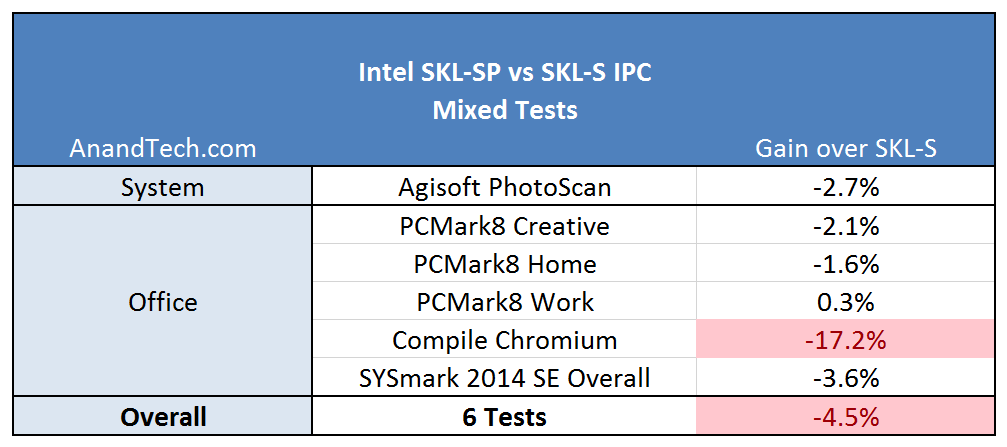The Intel Skylake-X Review: Core i9 7900X, i7 7820X and i7 7800X Tested
by Ian Cutress on June 19, 2017 9:01 AM ESTComparing Skylake-S and Skylake-X/SP Performance Clock-for-Clock
If you’ve read through the full review up to this point (and kudos), there should be three things that stick in the back of your mind about the new Skylake-SP cores: Cache, Mesh and AVX512. These are the three main features that separate the consumer grade Skylake-S core from this new core, and all three can have an impact in clock-for-clock performance. Even though the Skylake-S and the Skylake-SP are not competing in the same markets, it is still poignant to gather how much the changes affect the regular benchmark suite.
For this test, we took the Skylake-S based Core i5-6600 and the Skylake-SP based Core i9-7900X and ran them both with only 4 cores, no hyperthreading, and 3 GHz on all cores with no Turbo active. Both CPUs were run in high performance modes in the OS to restrict any time-to-idle, so it is worth noting here that we are not measuring power. This is just raw throughput.
Both of these cores support different DRAM frequencies, however: the i5-6600 lists DDR4-2133 as its maximum supported frequency, whereas the i9-7900X will run at DDR4-2400 at 2DPC. I queried a few colleagues as to what I should do here – technically the memory support is an extended element of the microarchitecture, and the caches/uncore/untile will be running at different frequencies, so how much of the system support should be chipped away for parity. The general consensus was to test with the supported frequencies, given this is how the parts ship.
For this analysis, each test was broken down in two ways: what sort of benchmark (single thread, multi-thread, mixed) and what category of benchmark (web, office, encode).
For the single threaded tests, results were generally positive. Kraken enjoyed the L2, and Dolphin emulation had a good gain as well. The legacy tests did not fair that great: 3DPM v1 has false sharing, which is likely taking a hit due to the increased L2 latency.
On the multithreaded tests, the big winner here was Corona. Corona is a high-performance renderer for Autodesk 3ds Max, showing that the larger L2 does a good job with its code base. The step back was in Handbrake – our testing does not implement any AVX512 code, but the L3 victim cache might be at play here over the L3 inclusive cache in SKL-S.
The mixed results are surprising: these tests vary with ST and MT parts to their computation, some being cache sensitive as well. The big outlier here is the compile test, indicating that the Skylake-SP might not be (clock for clock) a great compilation core. This is a result we can trace back to the L3 again, being a smaller non-inclusive cache. In our results database, we can see similar results when comparing a Ryzen 7 1700X, an 8-core 95W CPU with 16MB of L3 victim cache, is easily beaten by a Core i7-7700T, with 4 cores at 35W but has 8MB of inclusive L3 cache.
If we treat each of these tests with equal weighting, the overall result will offer a +0.5% gain to the new Skylake-SP core, which is with the margin of error. Nothing too much to be concerned about for most users (except perhaps people who compile all day), although again, these two cores are not in chips that directly compete. The 10-core SKL-SP chip still does the business on compiling:

If all these changes (minus AVX512) offer a +0.5% gain over the standard Skylake-S core, then one question worth asking is what was the point? The answer is usually simple, and I suspect involves scaling (moving to chips with more cores), but also customer related. Intel’s big money comes from the enterprise, and no doubt some of Intel’s internal metrics (as well as customer requests) point to a sizeable chunk of enterprise compute being L2 size limited. I’ll be looking forward to Johan’s review on the enterprise side when the time comes.













264 Comments
View All Comments
wolfemane - Monday, June 19, 2017 - link
First off, comments like yours contribute to absolutely nothing. Making whatever you say completely useless and more appropriate for deleting rather than individuals coming to conclusions based on what they read. At least they are posting on the topic at hand.Second, I read the article, and it was well done. My comments were directed at the very end of their conclusion and was basing my comments on a review that came out a few months after the original ryzen review. I got my articles mixed up, owned up to my mistake, and apologized.
What are you doing? Trolling....? How about adding something creative to the conversation instead of posting utterly pointless and useless dribble? Grow the F up.
Ryan Smith - Monday, June 19, 2017 - link
Wolfe, nested comments only display to 5 deep. They were responding to cheshirster, not you.=)bongey - Wednesday, August 2, 2017 - link
Don't be, they hammered Ryzen in gaming performance in their conclusion, even without benchmarks.That is clear evidence of shilling for Intel, following a narrative without any evidence."Gaming Performance, particularly towards 240 Hz gaming, is being questioned,"
"AMD has a strong workstation core "
cheshirster - Monday, June 19, 2017 - link
See herehttp://www.anandtech.com/show/11244/the-amd-ryzen-...
fullhd
i5 7600 - 139fps
1800X - 99fps
http://www.anandtech.com/show/11244/the-amd-ryzen-...
Rocker League fulhd
i5 7500 - 188fps
1800X - 132fps
And now they write
"Our GTX1080 seems to be hit the hardest out of our four GPUs, as well as Civilization 6, the second Rise of the Tomb Raider test, and Rocket League on all GPUs. As a result, we only posted a minor selection of results, most of which show good parity at 4K"
RoTR and GL, same games, same bad results, just different brands and now they are not going to publish them.
Ryan Smith - Monday, June 19, 2017 - link
It's important to note that the articles you quote are from the Ryzen 5 launch, which was over a month after the X370 platform. A lot of Ryzen's issues had been fixed in the weeks before.bongey - Wednesday, August 2, 2017 - link
In your conclusion intel shill"Gaming Performance, particularly towards 240 Hz gaming, is being questioned,"
"AMD has a strong workstation core "
koomba - Thursday, July 6, 2017 - link
Uhh, not sure what you are remembering, but Anandtechs initial Ryzen review most certainly did NOT include gaming benchmark.I think it's slightly amusing how many people here in the comments immediately jumped down the reviewers throat over no gaming reviews and the reason given for that. And then they proceed to spin that into some kind of perceived bias against Ryzen, like the author has some AMD bashing agenda.
You, and several others, are literally inventing "facts" to support accusations of bias and unequal treatment. Then to top it off, trying to say Anandtech reviewers are fan boys.
But in reality, the entire basis of all these claims of bias, etc is completely fabricated. So much for all that huh? Almost seems like overly defensive, some might even say fan boy behavior. Irony is present. lol.
bongey - Wednesday, August 2, 2017 - link
Nope they just bashed Ryzen in gaming in the conclusion even without benchmarks."Gaming Performance, particularly towards 240 Hz gaming, is being questioned,"
"AMD has a strong workstation core "
Slappi2 - Monday, June 19, 2017 - link
Wow AMD gets stomped here. No way I would buy an AMD CPU after seeing that.R0H1T - Monday, June 19, 2017 - link
Sure now enjoy your 10 core space heater ~www.tomshardware.com/reviews/intel-core-i9-7900x-skylake-x,5092-11.html